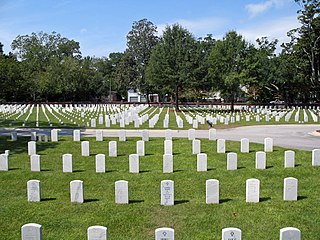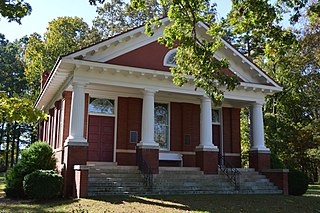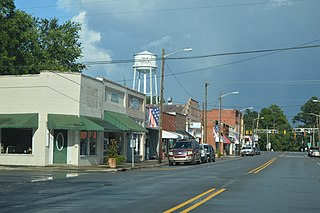
Clinton is a city in, and the county seat of, Sampson County, North Carolina, United States. The population of Clinton is 8,639 according to the 2010 Census. Clinton is named for Richard Clinton, a Brigadier General of the North Carolina militia in the American Revolution.

Faison is a town in Duplin County in the U.S. state of North Carolina. The population was 961 at the 2010 census.

Old Chapel Hill Cemetery is a graveyard and national historic district located on the campus of the University of North Carolina at Chapel Hill in Chapel Hill, North Carolina.

Bartlett Yancey was a Democratic-Republican U.S. congressman from North Carolina, United States, between 1813 and 1817.

Wilmington National Cemetery is a United States National Cemetery located in the city of Wilmington, in New Hanover County, North Carolina. Administered by the United States Department of Veterans Affairs, it encompasses 5.1 acres (2.1 ha), and as of the end of 2005, had over 6,000 interred remains.
Ninety Six National Historic Site, also known as Old Ninety Six and Star Fort, is a United States National Historic Site located about 60 miles south of Greenville, South Carolina. The historic site was listed on the National Register in 1969, declared to be a National Historic Landmark in 1973, and established as a National Historic Site in 1976 to preserve the original site of Ninety Six, South Carolina, a small town established in the early 18th century. It encompasses 1,022 acres of property.

Charles Aurelius Smith was the 91st governor of South Carolina from January 14 to January 19, 1915. His term of five days stands as the shortest for any governor in South Carolina.

The Montford Area Historic District is a mainly residential neighborhood in Asheville, North Carolina that is included in the National Register of Historic Places.

The Mordecai House, built in 1785, is a registered historical landmark and museum in Raleigh, North Carolina that is the centerpiece of Mordecai Historic Park, adjacent to the Historic Oakwood neighborhood. It is the oldest residence in Raleigh on its original foundation. In addition to the house, the Park includes the birthplace and childhood home of President Andrew Johnson, the Ellen Mordecai Garden, the Badger-Iredell Law Office, Allen Kitchen and St. Mark's Chapel, a popular site for weddings. It is located in the Mordecai Place Historic District.

Harshaw Chapel and Cemetery is a historic Methodist chapel and cemetery at Church and Central Streets in Murphy, Cherokee County, North Carolina. The chapel was built on land gifted to the church by Joshua Harshaw, who was a prominent slaveholder in the area. The chapel was completed May 1, 1869, and is a vernacular Greek Revival style brick church. The surrounding Murphy Methodist Cemetery contains graves dated as early as about 1840.

Griers Presbyterian Church and Cemetery is a historic Presbyterian church and cemetery located near Frogsboro, Caswell County, North Carolina. It was built about 1856, and is a simple, rectangular frame building. It is an example of Greek Revival temple-form church architecture. Also on the property is a contributing church cemetery.

Red House Presbyterian Church, also known as Hugh McAden Gravesite or Red House Church, is a historic Presbyterian church and cemetery located at 13409 NC 119 N in Semora, Caswell County, North Carolina. The Classical Revival red brick church building was constructed in 1913. It features a portico with four round, fluted wooden Doric order columns. Also on the property is a contributing church cemetery.

Abbott's Creek Primitive Baptist Church Cemetery is a historic Primitive Baptist church cemetery near Thomasville, Davidson County, North Carolina.

Quaker Meadows Cemetery is a historic cemetery located near Morganton, North Carolina. It includes 59 gravesites dated between 1767 and 1879; 53 of them are marked by gravestones. The earliest grave is of David McDowell (1767), the two-year-old grandson of Joseph McDowell, the first permanent white settler in the area.
Pilgrim Reformed Church Cemetery is a historic church cemetery located near Lexington, Davidson County, North Carolina. It is associated with the Pilgrim Reformed Church, founded about 1757 By a man of the name Valentine Leonhardt. It contains approximately 350 burials, with the earliest gravestone dated to 1781. It features a unique collection of folk gravestones by local stone cutters erected in Davidson County in the late-18th and first half of the 19th centuries. The church was the first Pilgrim church in North Carolina.
William Wright Faison House, also known as Friendship, is a historic plantation house located near Bowdens, Duplin County, North Carolina. It was built about 1852, and is a two-story, three bay by two bay, Greek Revival style frame dwelling. It features a tall portico supported by four paneled posts added about 1848. Also on the property is a contributing one-story school building. The house was the seat of a 3,500 acre plantation amassed by William Wright Faison before the American Civil War.

Faison Historic District is a national historic district located at Faison, Duplin County, North Carolina. The district encompasses 116 contributing buildings, 2 contributing structures, and 1 contributing object in the central business district and surrounding residential area of Faison. It includes industrial, residential, and commercial buildings with notable examples of Greek Revival, Queen Anne, and Italianate style architecture. Notable buildings include the Cates Pickle Company (1931), Moore Lee Thornton Store, C. S. Hines Store, Clifton's Service Station (1933), The Walter Livingston Hicks House, Faison Pharmacy, Witherington Building (1915), Faison Depot (1888), Presbyterian Church (1918), Elias Faison House, Faison-Williams House (1853), and Witherington House (1880).

Old White Church Cemetery, also known as Emanuel Church Cemetery, is a historic cemetery and national historic district located at Lincolnton, Lincoln County, North Carolina. It was established in 1788, and contains the marked graves of some 265 citizens of Lincolnton, with an even larger number of unmarked graves. The oldest marked grave dates to 1801. The gravestones include notable examples of 19th and early-20th century funerary art. It is the oldest burying ground in the town of Lincolnton.

Jackson Historic District is a national historic district located at Jackson, Northampton County, North Carolina. The district encompasses 168 contributing buildings, 2 contributing sites, 1 contributing structure, and 2 contributing objects in the central business district and surrounding residential sections of Jackson. The district developed between about 1825 and 1953 and includes notable examples of Federal and Greek Revival style architecture. Located in the district are the separately listed Amis-Bragg House, Church of the Saviour and Cemetery, and Northampton County Courthouse Square. Other notable contributing resources include Lewis Drug Store (1930), Kennedy's Five Cents to Five Dollars Store, Bank of Northampton (1928), Bowers Hardware Store, Atlas Oil Company Building, Farmer's Cotton Gin Complex, Faison House, Saint Catherine's Hall (1848), Judge Robert Peebles House (1890s), Selden-Boone House, Jackson Baptist Church (1881), and Jackson United Methodist Church (1937).
William E. Faison House is a historic home located near Giddensville in Sampson County, North Carolina. It was built about 1870, and is a two-story, double-pile, frame dwelling, with Greek Revival and Italianate style design elements. It has a hipped roof; one-story, gable roofed rear ell; and features a one-story front porch. Also on the property is the contributing family cemetery.



















